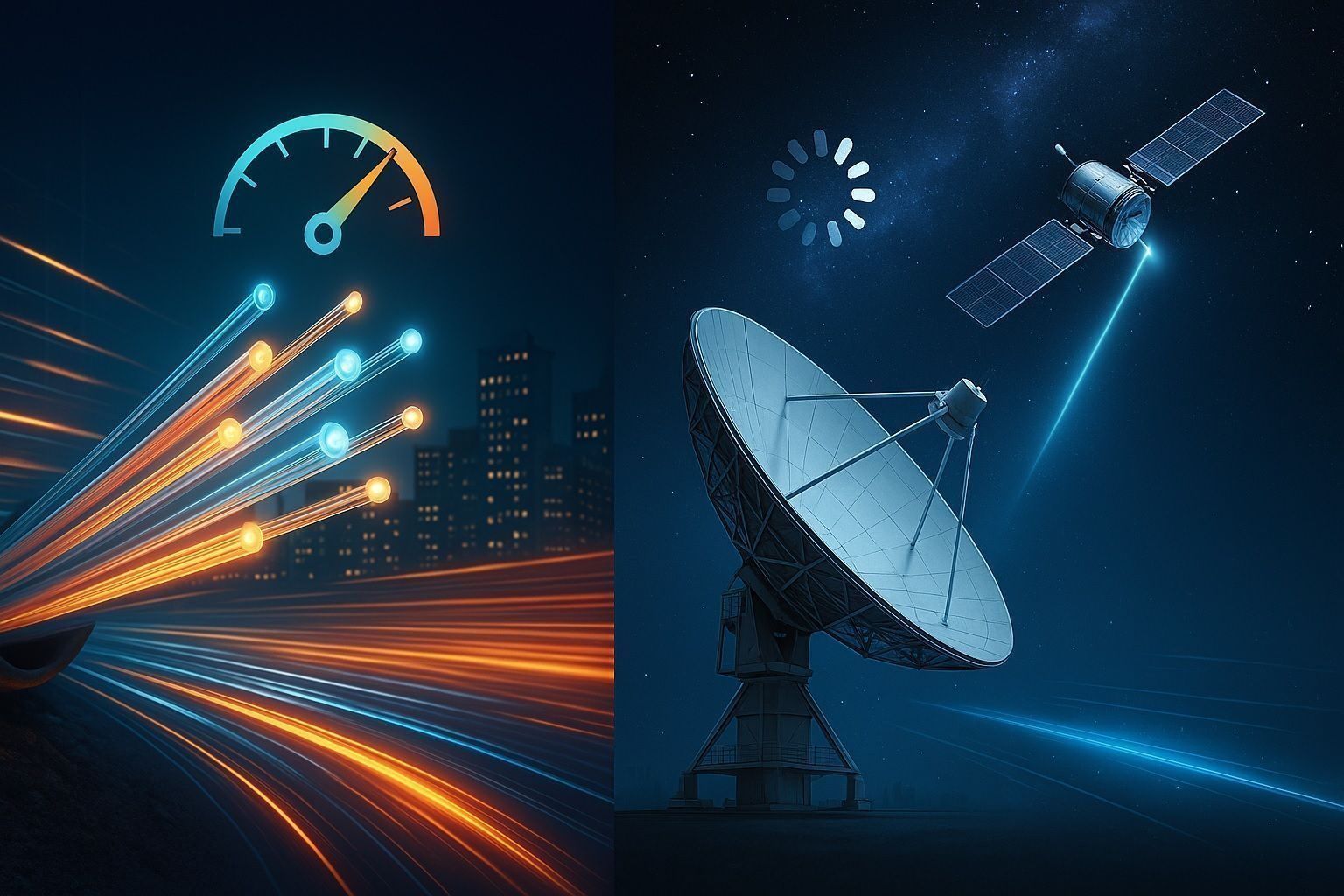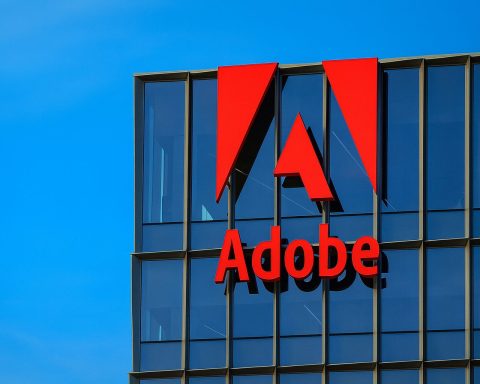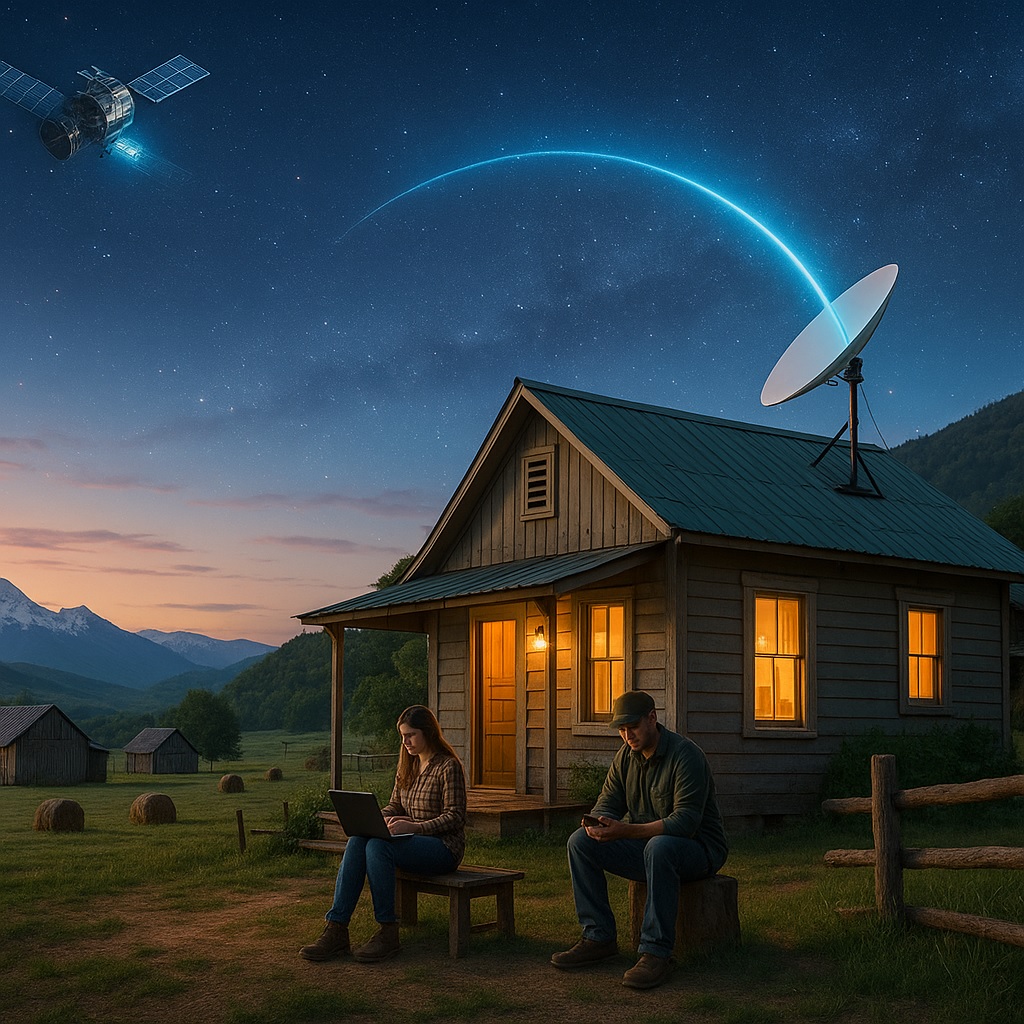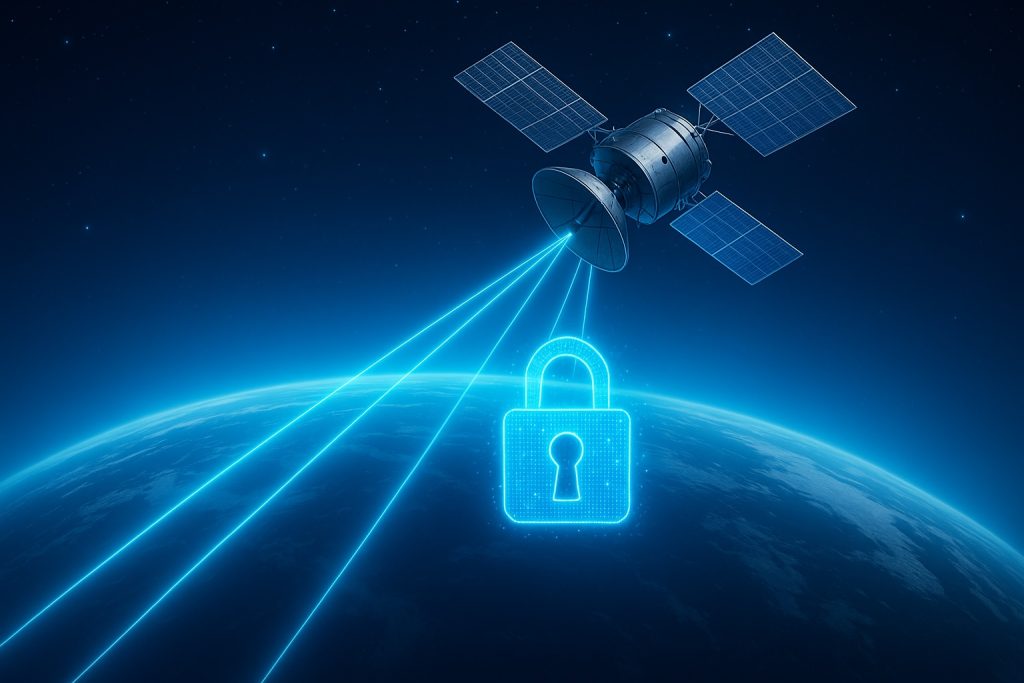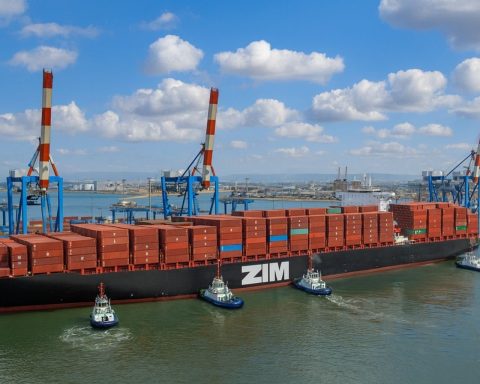- Fiber-optic broadband latency is typically a few milliseconds on local networks, with total latency to nearby servers generally in the 10–30 ms range.
- Geostationary satellites sit about 22,000 miles (35,000 km) above Earth, producing round-trip latencies of roughly 600–650 ms.
- Starlink uses a low-Earth orbit constellation, delivering typical latencies of about 20–50 ms and, by mid-2025, operating with nearly 7,000 satellites and over 1.4 million active US subscribers.
- Starlink typical download speeds are 50–150 Mbps (up to 200+ Mbps in ideal conditions) with uploads of 5–20 Mbps.
- Fiber gigabit plans are widely available, and many providers offer 2 Gbps, 5 Gbps, or even 10 Gbps services in 2025.
- In the United States, more than 76 million homes had fiber available by the end of 2024, while about 22% of rural Americans have no access to fixed broadband at 25 Mbps.
- Satellite coverage is available virtually anywhere with a clear sky; Starlink by mid-2025 covers most populated areas, and end-2024 global Starlink users were about 4.6 million.
- 5G fixed wireless home internet can deliver typical speeds of 100–500 Mbps with latency around 20–40 ms, depending on distance to towers and spectrum.
- Starlink hardware kit costs around $599 in the United States; fiber installations are often waived or priced low, depending on provider and region.
- Monthly costs vary: gigabit fiber commonly runs $70–$90, some promos around $50, while Starlink’s standard residential plan has been about $110–$120 per month in the U.S. in 2025.
In the race for high-speed internet, satellite and fiber-optic broadband represent two very different approaches. Fiber-optic (terrestrial broadband) is often considered the gold standard – delivering data at nearly the speed of light through glass cables buried underground or strung on poles [1]. Satellite internet, by contrast, beams data to orbiting satellites and back to Earth, enabling connectivity virtually anywhere on the planet. Each technology has unique strengths and weaknesses, especially when it comes to latency (network delay) and bandwidth (data throughput). This report provides an up-to-date comparison of satellite vs. fiber internet as of mid-2025, examining how they work, their typical performance, real-world use cases, coverage differences, infrastructure challenges, costs, and recent advancements like SpaceX’s Starlink and 5G broadband.
Technical Infrastructure: How Satellite and Fiber Internet Work
Fiber-Optic Broadband: Fiber internet transmits data as pulses of light through strands of glass fiber. Because information travels via light, fiber can carry enormous amounts of data at extremely high speeds – even up to gigabits per second – with very low signal attenuation. Fiber networks usually run directly to homes (FTTH) or to neighborhoods, providing a dedicated physical connection. The result is a fast and reliable link that isn’t affected by radio interference or weather. Data on fiber can literally travel at near light speed, making latency on fiber connections exceptionally low (often only a few milliseconds on local networks) [2] [3]. Fiber’s wired infrastructure requires significant construction – digging trenches or using utility poles to lay cable – but once in place, it offers unmatched stability and capacity.
Satellite Internet: Satellite connectivity uses wireless radio signals to send data between a user’s location and orbiting satellites. A customer installs a satellite dish (transceiver) at their home, which beams requests up to a satellite in space; the signal then goes down to a ground station connected to the internet backbone, and the process reverses for the return data [4]. Traditional satellite internet relied on geostationary satellites ~22,000 miles (35,000 km) above Earth. Because of this huge distance, the round-trip time for data is inherently high – a single signal round trip to a geostationary satellite takes on the order of 600–650 milliseconds at best [5] [6]. This added delay, or high latency, is the hallmark disadvantage of classic satellite internet. Newer systems like Starlink use low Earth orbit (LEO) satellites orbiting much closer (a few hundred miles up), dramatically cutting latency to tens of milliseconds [7]. However, LEO networks require many satellites moving in constellations and complex ground infrastructure to hand off connections. Satellite links are also wireless, so they can be disrupted by heavy rain or atmospheric conditions (known as rain fade), and require a clear line of sight to the sky. The key benefit of satellites is ubiquitous coverage – they can serve remote areas far beyond the reach of any fiber or cable line.
Latency and Bandwidth: Typical Performance Comparison
One of the starkest differences between satellite and fiber internet is in latency and bandwidth. Latency is the time it takes for data to travel from source to destination (often measured as a ping round-trip). Bandwidth is the data transfer rate (speed) of the connection. The table below compares these metrics for modern satellite services versus fiber broadband:
| Metric | Satellite Internet | Fiber Broadband (Terrestrial) |
|---|---|---|
| Typical Latency | ~20–50 ms with LEO satellite (e.g. Starlink) [8] [9]; 600+ ms with older geostationary satellites [10] [11]. | ~5–20 ms on wired networks (often <10 ms on fiber) [12] [13]. |
| Download Speeds | ~50–150 Mbps typical on Starlink (can reach 200+ Mbps) [14] [15]; legacy satellite services ~12–25 Mbps [16]. Future LEO plans aim for ~1 Gbps. [17] | Commonly 100–1000+ Mbps (up to multi-gigabit on fiber) [18] [19]. Top-tier fiber plans can exceed 1–10 Gbps. |
| Upload Speeds | ~5–20 Mbps on Starlink LEO [20]; often 3 Mbps or less on older satellites. | Often 100–1000+ Mbps on fiber (symmetrical to download) [21] [22]. Cable broadband offers lower uploads (e.g. 10–50 Mbps) but fiber is usually symmetric. |
| Reliability | Affected by weather (rain, storms) and satellite coverage gaps; possible brief dropouts or higher jitter [23] [24]. Newer constellations mitigate this with many satellites, but network load can impact performance [25]. | Very high reliability; not weather-sensitive [26]. Fiber lines are resilient if underground, though physical cable cuts can occur. Performance is consistent and not shared over the air. |
| Data Caps | Often imposed on traditional satellite plans (e.g. 50–150 GB/month then throttling) due to limited capacity. Starlink offers “unlimited” data but may throttle heavy users via fair use policies [27]. | Typically no hard caps on wired broadband. Most fiber/cable plans offer unlimited data (or extremely high caps) given the greater network capacity. |
Latency: The propagation delay in fiber is negligible for most purposes – a packet can go hundreds of miles in a few milliseconds. Total latency on fiber broadband is usually dominated by routing and server distance, often in the range of 10–30 ms for nearby servers [28]. Satellite latency, on the other hand, depends on orbital altitude. Traditional GEO satellites induce half-second delays each way; even under ideal conditions ping times around 600 ms are common [29] [30]. Such high latency is very noticeable in interactive applications. LEO satellites like Starlink have narrowed this gap: Starlink advertises ~25–50 ms typical latency on land [31] [32], which is on par with some cable/DSL connections. Indeed, in late 2024 Starlink users in the UK saw median latency of ~41 ms [33]. Still, fiber’s latency advantage remains – fiber to a nearby destination can be just ~2–5 ms [34], and terrestrial paths avoid the extra hops of space. Low latency gives fiber an edge for real-time responsiveness.
Bandwidth: Fiber is currently king of speed. Gigabit (1000 Mbps) fiber plans are widely available, and many providers offer 2 Gbps, 5 Gbps or even 10 Gbps services in 2025 for those who need them [35]. Even average home fiber connections often reach hundreds of Mbps. Satellite bandwidth has historically been limited – older services might top out at 12–25 Mbps download [36]. Modern high-throughput satellites and LEO constellations improved this significantly. SpaceX Starlink users typically see anywhere from ~50 Mbps up to 150–200 Mbps download, depending on network load [37]. Starlink’s own reports show most users get 100+ Mbps download and around 10 Mbps upload [38]. In ideal conditions some Starlink users have hit 200+ Mbps. However, speeds can vary with satellite network congestion – e.g. as more customers join, median Starlink speeds in some regions have fluctuated or declined [39] [40]. Fiber’s capacity is essentially limited by the equipment (it can be upgraded by changing the lasers/modems), making multi-gigabit speeds feasible, whereas satellite capacity is shared among users in a beam and constrained by spectrum. Notably, Starlink aims for 1 Gbps in the future with a larger constellation, but this remains a goal [41].
Consistency and Jitter: Beyond raw throughput, fiber tends to offer more consistent performance and lower jitter (variance in latency). Satellite links – especially if the signal is relayed across moving satellites – can have more variability. Users have reported Starlink latency sometimes spikes (e.g. brief jumps to 100–200+ ms) due to satellite handoffs or network switching, though it averages low [42]. Geostationary satellite users can experience variable throughput and slowdowns during peak times as well [43]. Fiber’s direct, wired path means each packet experiences a stable transit time, which benefits applications like online gaming or VoIP that are sensitive to jitter.
Real-World Performance in Common Use Cases
How do satellite and fiber internet impact everyday online activities? Below we examine several use cases and how each technology fares:
- Video Streaming: Streaming movies or TV (e.g. Netflix, YouTube) requires consistent bandwidth more than low latency. A high-definition 1080p stream might need ~5–10 Mbps, and 4K HDR video can demand 25 Mbps or more. Fiber easily handles multiple 4K streams simultaneously thanks to its high speeds and unlimited data. Buffering is rare on fiber unless the streaming server itself is slow. Satellite (LEO) can stream HD and even 4K content on a single screen without issue when running at 50–100+ Mbps speeds. Starlink’s bandwidth is sufficient for streaming, and it touts being suitable for video streaming use [44]. However, if multiple devices are streaming or if network congestion occurs, satellite users might see quality drop to lower resolutions. Also, many satellite plans (especially older GEO systems) enforce data caps – after a certain amount of GB, the speed may be throttled, making further streaming difficult. Weather interference can also cause momentary drops in satellite streaming. Overall, streaming video is forgiving of latency (since buffering can cover delays), so even GEO satellites (600 ms latency) can stream content as long as bandwidth holds up. But on GEO plans with 10–25 Mbps and strict data limits, one high-quality stream could max out the connection or consume the monthly allowance. Fiber has the clear advantage for heavy streaming households or 4K binge-watching, whereas satellite can support casual streaming or single-stream use with some caution to data usage.
- Online Gaming: Real-time multiplayer games (e.g. first-person shooters, MMOs) are highly sensitive to latency and jitter. Fiber provides the best gaming experience – its latency of ~5–20 ms locally means almost instant server responses, and minimal jitter ensures smooth gameplay. Fast-paced competitive gamers absolutely prefer fiber or cable connections for the lowest ping. Satellite (LEO) like Starlink can enable online gaming in a way older satellites never could. With Starlink’s latency in the 30–50 ms range, many online games are playable [45]. Casual gaming, RPGs, turn-based games, or cloud-streamed games can work fine. However, even ~40 ms baseline latency is on the high end for competitive eSports, and Starlink users have noted occasional latency spikes or brief dropouts that can interfere with fast action games [46] [47]. GEO satellite (600+ ms ping) makes fast-twitch gaming impractical – the delay would cause severe lag and frustration in any action game [48]. Additionally, satellite connections may have higher packet loss during bad weather or network switching, which can kick players from game sessions. In summary, fiber or wired broadband is strongly recommended for serious gamers or twitch-sensitive games, whereas Starlink satellite can be usable for moderate gaming but might not meet the demands of professional or highly competitive play. Traditional GEO satellite is generally a poor choice for gaming due to high latency.
- Video Conferencing & Voice Calls: Zoom, Microsoft Teams, Skype, VoIP phone calls require low latency and stable throughput for real-time two-way communication. Fiber handles video conferences effortlessly – the low latency means minimal delay between participants, and high upload speeds support HD video upstream. With fiber, even group calls with HD video for each participant are smooth, and there’s plenty of bandwidth for screen sharing, etc. Satellite (LEO) can adequately support video calls as well. Starlink’s latency of ~30–50 ms is within a tolerable range for conversational lag (a 0.03–0.05 second delay is barely noticeable). Indeed, Starlink explicitly markets itself as suitable for video calls and VoIP [49]. Most users can use Zoom or Teams on Starlink with only occasional hiccups, though quality might drop to maintain stability if network conditions vary. One challenge is that if a satellite connection experiences a brief outage or switch (even a few seconds), a live video call can freeze or drop – something fiber rarely encounters. GEO satellite, on the other hand, struggles with real-time video chat: a 600 ms ping introduces a noticeable half-second talk delay, leading to people talking over each other. It’s still possible to hold a conversation, but it feels more like using an old satellite phone – awkward pauses and echoes. Additionally, VPNs used in remote work may not perform well over high-latency links [50]. Overall, for remote work and virtual meetings, fiber provides a virtually seamless experience, while Starlink can usually handle the demands with minor latency and reliability compromises. Older satellite services make video conferencing cumbersome and are typically a last resort for remote workers.
- General Browsing and Downloads: For everyday web browsing, email, social media, or downloading files, both technologies can serve the need but with different user experiences. On fiber, browsing is snappy – web pages load quickly, and multiple devices can download or update software concurrently without slowdowns. Large file downloads or software updates (which can be multiple gigabytes) are fast on fiber; a 10 GB file might download in under 2 minutes on a gigabit fiber line (assuming the source is fast enough). On satellite, basic web browsing is fine for the most part. Simple pages load with a slight extra delay on Starlink versus fiber, but it’s quite manageable. On a GEO satellite link, the latency can make websites feel sluggish – each new webpage might take an extra half second or more before it starts loading [51] [52], which adds up as elements load sequentially. Modern websites with many assets can be slow over high-latency links due to all the round-trip requests. Starlink’s latency largely solves this, making web browsing similar to a DSL or cable experience. For downloading files, Starlink’s ~50–150 Mbps speed means a multi-gigabyte game download will still take a bit of time (for example, a 40 GB game might download in an hour or two at ~100 Mbps). Fiber could do the same in a few minutes. Furthermore, if the satellite plan has data limits, a huge download may push the user into throttled bandwidth for the rest of the month. In general, fiber shines for heavy downloading and cloud syncing, whereas satellite is adequate for moderate use but one must be mindful of data usage and potential slowdowns on very large transfers.
In summary, fiber broadband provides superior performance across almost all common use cases, thanks to its low latency, high speeds, and reliability. Satellite internet (particularly modern LEO-based) has greatly improved and is now capable of supporting everyday activities – including streaming and video calls – that were once very challenging on satellite. For a single user or light household, a service like Starlink can feel nearly comparable to a basic cable connection for general internet use. However, under the stress of multiple simultaneous high-bandwidth tasks or for latency-critical applications, satellite still falls short of fiber’s performance. Legacy geostationary satellite internet remains suitable only for basic needs (email, simple browsing, streaming at lower quality) and is not ideal for interactive or data-intensive tasks.
Coverage and Availability: Reaching Urban vs. Rural Areas
Fiber Broadband Coverage: Fiber-optic internet offers fantastic performance but is inherently limited by where infrastructure has been deployed. Running fiber cables to every home is a massive undertaking, and as of 2025 it is still an ongoing process, especially in sparsely populated areas. Urban and suburban areas have seen rapid fiber expansion – in the U.S., over 76 million homes had fiber available by the end of 2024 [53], and tens of millions of new fiber passings are being added each year. Many cities now have at least one fiber provider (or high-speed cable as an alternative). In contrast, rural areas often lack fiber or even any broadband cables. Laying new cable across long distances for only a few customers can be cost-prohibitive without subsidies (as discussed in the next section). As a result, a significant portion of rural populations remain unserved or underserved by terrestrial broadband. For example, roughly 22% of Americans in rural areas have no access to fixed broadband at the basic 25 Mbps level, compared to only 1.5% of urban Americans [54]. These rural users typically have to rely on older phone-line DSL, fixed wireless, or satellite options if fiber/cable isn’t available. Even in countries with aggressive fiber programs, remote villages or islands can be left out due to the high costs of reaching them. In summary, fiber’s availability is excellent in many urban regions (and improving year by year), but spotty to nonexistent in many rural or hard-to-reach locales. Governments are investing in broadband initiatives to extend fiber into rural areas, but those projects take time and billions of dollars.
Satellite Coverage: Satellite internet is available virtually anywhere on Earth with a clear view of the sky. This is the prime appeal of satellite service – geography matters little. Whether on a mountaintop, a farm, a boat at sea, or an isolated village, a user can connect via satellite as long as they are within the satellite’s footprint and have the necessary equipment. Traditional GEO satellite providers (like HughesNet, Viasat) cover large continental areas (sometimes entire hemispheres) with just a few satellites. Modern LEO constellations like Starlink are aiming for global coverage with hundreds or thousands of satellites: Starlink already serves most of North America, Europe, and many other regions, and by end of 2024 had about 4.6 million customers globally [55] including users in very remote places. By mid-2025, Starlink’s coverage spans most populated areas, though service at extreme polar latitudes is still rolling out. The advantage in rural areas is clear – satellite can reach where fiber and cellular networks have not. However, coverage is not entirely uniform: Starlink, for instance, has capacity limits in each cell, so popular rural regions can have waitlists once too many users sign up in the same area. Additionally, physical obstructions (mountains, trees, buildings) can impede a satellite dish’s view of the sky; dense urban cores with tall buildings might not be ideal for Starlink because of blocked sky views (ironically, cities have fiber anyway). Portability is another aspect of coverage – certain satellite plans allow customers to take their dish anywhere (for example, on an RV or boat) and still get internet, something fiber cannot offer at all. In short, satellite offers unparalleled reach, making broadband available in places that are completely off the wired grid. The trade-off is that in areas where both options exist, satellite is usually chosen only if fiber or cable isn’t an option or if portability is needed.
It’s worth noting that other broadband technologies also play roles in coverage: Cable internet (coaxial cable) covers many suburbs and towns (though not as fast as fiber, it’s widely available), and 5G fixed wireless is emerging in both urban and rural markets as well. 5G home internet uses cellular towers to beam internet to homes, and carriers have expanded 5G coverage rapidly. Where available, 5G can deliver anywhere from 100 Mbps up to 1 Gbps wirelessly [56] [57], making it a competitor to wired service. However, like fiber, 5G coverage still has gaps in rural areas and can be limited by distance to cell towers. We’ll discuss 5G further in the advancements section, but from a pure coverage standpoint, satellite remains the only broadband option that is practically global – an important lifeline for rural communities, maritime and in-flight connectivity, and developing regions without terrestrial network infrastructure.
Infrastructure Requirements and Deployment Challenges
Rolling out fiber or satellite internet requires very different infrastructure investments, each with its own challenges:
- Fiber Infrastructure: Deploying fiber-optic cables is labor-intensive and capital-intensive. It involves either burying cables underground (which means trenching or directional drilling, dealing with permits, rights-of-way, and potential disruption of roads/property) or stringing cables on utility poles (which can be quicker but requires pole access agreements and has exposure to weather/tree damage). The cost of laying fiber can range from tens of thousands of dollars per mile in easy terrain [58] to over $50,000–$80,000 per mile in more difficult areas [59] – and in extremely remote or harsh environments, the cost per home can skyrocket. For instance, certain government-subsidized rural fiber projects in Alaska and Texas were estimated at $60,000–$200,000+ per household passed due to the challenging terrain and sparse population [60] [61]. More typically, in suburban deployments, efficient providers report costs around $1,000 or less per home passed [62], but reaching that last 5% of rural homes is where costs explode. Besides the cable itself, fiber networks require hubs or central offices with optical line terminals, local power, and maintenance crews to repair cuts or outages. Time is a challenge – fiber rollout is slow relative to wireless. It can take months or years to plan and build out a new fiber network to a community. Despite these challenges, the long-term benefit is a future-proof infrastructure: once fiber is in the ground, it can be lit with new equipment to greatly increase capacity, and maintenance costs are relatively low. Reliability is generally excellent, but not absolute – fibers can be accidentally cut by construction or natural disasters, which will disrupt service until repaired. In summary, fiber requires a high upfront investment in physical infrastructure and is constrained by geography and population density economics.
- Satellite Infrastructure: Satellite networks front-load their costs in the space segment. Building and launching satellites is extremely expensive – a single communications satellite can cost hundreds of millions of dollars, and launching hundreds or thousands of them (as with Starlink’s LEO constellation) involves significant ongoing rocket launch costs. That said, each satellite can cover a broad area and serve many users at once, so the cost per user can come down with scale. One of the biggest challenges for satellite internet is capacity: satellites have finite bandwidth (limited by frequency spectrum and onboard technology). This is why older GEO satellites enforced strict data caps – they simply couldn’t serve unlimited data to everyone under their footprint. Newer high-throughput satellites and LEO constellations add more total capacity, but they still face spectrum limits and congestion as user numbers grow [63]. On the ground, satellite internet requires establishing ground stations (gateway earth stations) that connect the satellite network to the internet fiber backbone. These gateways need to be placed in areas with good connectivity and clear skies, often requiring many around the globe for LEO networks. For the end user, the infrastructure is simpler: a satellite dish kit and modem. Starlink, for example, sells a kit (dish, stand, Wi-Fi router) for a few hundred dollars that users install themselves [64]. Installing the user equipment is relatively quick (mount and power on), especially compared to waiting for a fiber line installation. Deployment speed is a big satellite advantage – SpaceX can launch dozens of satellites in one rocket and light up coverage in new regions much faster than a fiber build-out would. However, launching satellites isn’t instant either (Starlink’s constellation is still growing to meet demand). Satellites also have finite lifespans (LEO satellites might need replacement every 5-7 years due to orbital decay or technology refresh), meaning the network must continually be maintained and updated in space. Another challenge: orbital mechanics and interference – managing thousands of fast-moving satellites without them colliding (space debris risk) and coordinating spectrum use requires advanced technology and regulatory coordination. From a reliability standpoint, satellite internet can be impacted by factors like solar storms or spacecraft malfunctions, but the distributed nature of constellations can route around single-satellite issues. The user experience can degrade in bad weather (rain or snow attenuating the signal), something fiber doesn’t worry about. All considered, satellite internet infrastructure excels in reaching anywhere without terrestrial build costs, but comes with high technology costs, complex logistics, and capacity trade-offs that terrestrial fiber networks don’t face.
- Maintenance and Scalability: Maintaining fiber often means sending technicians to repair cut lines or upgrade equipment, whereas maintaining satellites involves monitoring from control centers and replacing units at end-of-life (via new launches). Scaling up fiber capacity might mean adding more fibers or upgrading transceivers – relatively straightforward if the fiber is already in the ground. Scaling up satellite capacity means launching more satellites or using higher throughput technology (also not trivial, but ongoing – e.g. Starlink keeps launching more satellites and experimenting with laser inter-satellite links to increase efficiency). Importantly, scale economics favor satellites in coverage (one satellite can cover many new users), but favor fiber in capacity per user (especially in dense areas – serving a city with fiber yields enormous shared capacity via many fibers, whereas a few satellites could be overwhelmed by an urban population’s data demand).
In many cases, the two infrastructures are complementary. We often see hybrid approaches: fiber is used in towns and cities, while satellites (or fixed wireless) fill the gaps for remote areas. Governments might choose to subsidize fiber to as many places as feasible, then rely on satellite for the hardest-to-reach locales where fiber is impractical. Both fiber and satellite also rely on each other at times – for instance, satellite gateways connect into fiber backbones, and fiber networks may use satellite for backup links or to reach overseas territories without submarine cables. The ongoing challenge for policymakers and providers is balancing these technologies to achieve ubiquitous coverage without excessive cost.
Cost Comparison: Installation and Ongoing Service Fees
Cost is a deciding factor for many when comparing internet options. Here’s how satellite and fiber stack up in terms of both upfront installation and monthly pricing:
- Upfront Installation/Equipment Costs: Fiber installation to a home can range from free to a modest fee for the customer, depending on the provider and region. Many fiber ISPs waive installation fees or charge perhaps $100 or less, especially in competitive urban markets or with a contract. The expensive part – digging trenches, running cable – is often subsidized by the provider or government grants, so the end user doesn’t pay the true infrastructure cost directly (except through their monthly fee). In new residential developments, the cost may be baked into construction. Satellite internet usually requires the customer to purchase specialized equipment. Starlink, for example, currently prices its hardware kit around $599 in the US (around £299 in the UK) [65], though promotions and regional pricing vary. Some GEO satellite providers offer a dish for free or a small rental if you sign a term contract, but often there is an equipment lease or purchase fee. The satellite dish typically needs professional or self installation (mounting it on a roof or pole). Starlink is designed for easy self-install (just point it at the sky and it auto-aligns) [66], but not everyone is comfortable climbing roofs, so there could be costs if a third-party installer is hired. In short, satellite tends to have higher upfront user costs for equipment, whereas fiber’s massive infrastructure cost is hidden from the consumer aside from installation fees that are sometimes waived.
- Monthly Service Pricing: Internet service prices vary by region and provider, but some general trends can be noted. Fiber broadband is often competitively priced relative to its speed. In the U.S., for instance, a common gigabit fiber plan might cost $70–$90 per month, and some providers offer promotional rates (one provider advertises $50/month for 1 Gbps service [67]). Lower-tier fiber plans (100 Mbps or 200 Mbps) can be as low as $30–$50 in some markets [68]. Prices in Europe or Asia for fiber can be even lower per Mbit in many cases due to competition. Overall, the cost per Mbps on fiber is very low. Satellite internet historically was more expensive for less speed. Traditional GEO satellite plans (e.g. 25 Mbps) often cost $50–$150 per month, not including equipment, and with strict data limits. Starlink has somewhat standardized pricing – in the U.S. it has been around $110–$120 per month for the standard residential plan (unlimited data) in 2025, while offering cheaper plans in some developing regions, and more expensive “Priority” or mobile plans for businesses or RV users. The UK pricing example is ~£75 per month [69]. So satellite service is generally as expensive or more expensive than top-tier fiber, despite offering lower performance. As an example, a fiber user might pay $60/month for 500 Mbps unlimited, while a Starlink user pays $110/month for maybe 100 Mbps on average. That said, when satellite is the only option, people are often willing to pay a premium for broadband connectivity. The cost structure also differs: fiber ISPs often require contracts or have early termination fees, whereas Starlink is month-to-month (but you bought the hardware upfront). Some fiber providers bundle TV or phone service which can change value perception. According to industry reports, fiber typically runs cheaper than satellite for equivalent service levels [70] – partly because the ongoing costs for fiber (maintenance, electricity for amplifiers) are lower than the costs for operating a satellite constellation and teleport network.
- Value and Hidden Costs: One must also consider data caps and overage fees. Most fiber plans are unlimited, so no extra fees for heavy usage. Satellite providers sometimes have “priority data” limits – for example, Starlink has a Fair Use Policy where residential users who exceed a certain threshold (e.g. 1 TB in a month) might get deprioritized in congested hours [71]. Traditional satellite plans might charge extra for additional data or simply slow your speeds drastically after the cap. This effectively means heavy users could incur higher costs or reduced service on satellite. Equipment maintenance or replacement is another cost: a fiber user typically rents or is given an optical modem/router (sometimes with a small rental fee like $5–$10/month, or they can use their own). A satellite user owns their dish – if it breaks out of warranty, that’s a few hundred dollars to replace. On the flip side, fiber users usually don’t have to worry about relocating costs; if you move house within the provider’s network, they often install fiber at the new location for a nominal fee or free. With satellite, you can technically take your dish anywhere (for Starlink’s roam service) but you might pay a higher roaming fee or need a different service tier.
In sum, fiber is generally more cost-effective for the speeds and reliability it delivers – if it’s available. You pay less money per megabit and typically face fewer ancillary charges. Satellite is often a more expensive choice for inferior speeds, largely due to the high technology cost and lack of competition in remote areas (though Starlink has been pressuring legacy providers to lower prices somewhat). The calculation changes when considering areas where building fiber would cost tens of thousands per customer – there, a $600 dish and $100/month satellite link is far cheaper from a societal investment standpoint than running a fiber line, which is why satellite remains relevant. For consumers, when both options are on the table, fiber usually wins on the budget unless one needs the unique aspects of satellite (mobility or availability). It’s also worth noting the emergence of 5G fixed wireless as a cost competitor: cellular carriers are offering home internet for roughly $50–$80/month with no install fee (just a plug-and-play 5G receiver). Those services, where available, undercut satellite on price and challenge entry-level cable/fiber plans, giving consumers in some areas a third option for broadband.
Recent Advancements and Future Outlook
The landscape of internet connectivity is continually evolving. In recent years, two developments have particularly drawn attention: low Earth orbit satellite megaconstellations (epitomized by Starlink) and 5G wireless broadband. These technologies promise to bridge gaps and push performance closer to fiber in different ways.
- Starlink and Next-Generation Satellites: SpaceX’s Starlink has revolutionized the notion of satellite internet. By deploying thousands of LEO satellites, Starlink drastically lowered latency from ~600 ms (GEO) to ~30–50 ms and boosted real-world speeds into the 50–200 Mbps range [72] [73]. As of mid-2025, Starlink is operating with nearly 7,000 satellites in orbit and around 1.4+ million active subscribers in the U.S. (and more worldwide) [74]. Competing LEO constellations are on the horizon too: OneWeb (now partially live, focused on enterprise/rural telcos), Amazon’s Project Kuiper (preparing to launch its first batches of satellites), and others from China and the EU in planning. These next-gen satellites often incorporate inter-satellite laser links to route data in space, potentially reducing the need for as many ground stations and cutting latency further for long-distance links. In fact, Starlink has tested satellite-to-satellite laser relays that could eventually allow data to traverse the globe in space faster than through fiber (because straight-line through vacuum can beat the longer terrestrial fiber routes for intercontinental paths). While that is a future scenario, it hints at satellites complementing fiber for specialized low-latency long-haul routes. In the near term, Starlink is also rolling out Starlink “V2 Mini” satellites with improved bandwidth and plans for a satellite-to-cellular service (leveraging Starlink to connect ordinary cell phones in remote areas). All these advancements aim to increase satellite capacity and integration. Still, challenges remain: Starlink’s performance has seen capacity pressure – as user counts doubled in a year, median speeds in some countries have dipped [75]. SpaceX is addressing this by launching more satellites (including second-generation models) and Starship rocket promises to deploy even larger satellites in the future. Regulatory support and spectrum are also key – governments are looking at satellites as part of the broadband solution mix (the FCC has included satellite options in rural broadband funding for certain scenarios). In summary, the gap between satellite and terrestrial broadband is closing thanks to LEO constellations. By 2025, satellite internet is no longer a last-resort, sub-DSL experience but a legitimately broadband service for many. The next few years will determine how close it can get to fiber-like performance and whether it can sustain quality as networks scale up.
- 5G-Backed Broadband (Fixed Wireless): The rollout of 5G cellular networks has opened another avenue for high-speed internet access: using mobile network technology to deliver home broadband. Telecom providers like Verizon, AT&T, and T-Mobile in the US (and counterparts worldwide) have introduced 5G Home Internet services that use 5G signals from nearby cell towers to feed a home Wi-Fi router. The appeal is that it leverages existing wireless infrastructure – no need to run a cable to the house. In terms of speed, 5G can be very impressive: in ideal conditions (especially with mmWave spectrum or mid-band 5G), users can see hundreds of Mbps. Typical real-world 5G home internet speeds range widely from ~100 Mbps up to 300–500 Mbps in many cases [76], and some users near a mmWave transmitter might get near-gigabit speeds. Latency on 5G is low – theoretically 1–10 ms, but in practice often around ~20–40 ms, similar to cable or DSL ping times [77] [78]. As a result, 5G fixed wireless can support gaming and video calls nearly as well as wired broadband. It’s not as consistent as fiber (speeds can fluctuate with signal strength, weather, network congestion, etc.), but it’s improving. Coverage for 5G home internet is expanding; carriers are primarily targeting areas where they have excess capacity – often suburban or rural fringes that lack fiber but have some 5G signal. This has already started to erode satellite’s market in some areas, since if you can get 100 Mbps over 5G for $50/month, you wouldn’t opt for 100 Mbps over Starlink for double the price. However, 5G coverage still has gaps in very rural areas, especially those far from any cell site. Upcoming advancements like 5G mid-band spectrum deployment and eventually 6G will continue to increase wireless home internet speeds and capacity. Fixed wireless access (FWA) using 5G is seen as a key tool in reaching the rural homes that fiber might not get to soon – it’s quicker and cheaper to install than fiber (just set up tower equipment and receivers). Some projections suggest FWA will capture a significant chunk of the home broadband market in the next 5 years. That said, fiber remains the more future-proof solution where it can be economically deployed, and fiber networks often underlie 5G (since 5G towers need fiber backhaul). In essence, 5G and satellite are not just competing with each other but also jointly expanding the broadband map into territories that were previously underserved. The two also might converge: as mentioned, satellite-direct-to-phone services are in development (Starlink with T-Mobile, AST SpaceMobile’s satellite-cell hybrid, etc.), potentially making the sky itself a 5G cell tower.
- Other Notable Advancements: The fiber world is not standing still either. Fiber technology is progressing with new standards like XGS-PON and 25G/50G PON, enabling multi-gigabit home connections over the existing fiber strands. There’s ongoing work on reducing fiber latency further for specialized uses (though it’s already very low, techniques like routing optimization and using more direct fiber paths can shave milliseconds which matters for high-frequency trading or VR/AR applications in the future). Additionally, initiatives to simplify fiber deployment – such as cheaper roll-out techniques, micro-trenching, or even innovations like Alphabet’s Project Taara (which uses airborne lasers as “wireless fiber” links) – could accelerate fiber reach. On the satellite side, higher-frequency bands (like V-band) and new modulation techniques are being tested to boost capacity. We may see geo-satellites with onboard processing and higher throughput complement LEO constellations to serve dense areas. Also, integration of satellite with 5G is a trend: standards for Non-Terrestrial Networks (NTN) in 5G allow phones to seamlessly use satellite when out of cell range – future phones might just use satellite internet in the background when needed, without the user even thinking about it.
Looking ahead, the broadband ecosystem of 2025 and beyond is shaping up to be a mix of fiber, 5G, and satellites, each used where they make the most sense. Fiber will continue to expand in urban/suburban zones and remains the benchmark for high-performance connectivity. Satellite constellations like Starlink will fill coverage gaps and serve mobile/travel needs, with improving speeds that inch closer to terrestrial service. 5G fixed wireless will offer a competitive alternative in areas with good cellular coverage, potentially at lower price points or for those who prioritize easy setup. For consumers, this is good news – more options and technologies vying to provide fast internet. For remote communities, these advancements mean the digital divide can be narrowed: if fiber won’t come, perhaps LEO satellites or 5G will deliver broadband in the meantime. Each technology has its role: fiber for capacity and low latency, satellite for reach, and 5G for flexible wireless deployment. Rather than one replacing the other outright, we’re likely to see a continued patchwork of solutions working in tandem to meet the world’s growing connectivity demands.
Conclusion
In comparing satellite and fiber internet, it becomes clear that fiber-optic broadband is superior in raw performance – it offers the lowest latency, highest bandwidth, and most reliable service, making it ideal for nearly all high-demand applications from streaming and gaming to remote work. If you have access to fiber (or comparable wired service like cable), it will generally provide a better and more cost-effective internet experience than any satellite option. Satellite internet, however, plays an invaluable role where wired networks can’t reach. Thanks to innovations like Starlink’s LEO constellation, satellite connectivity in 2025 is a far cry from the slow, laggy service of the past: it now delivers genuinely broadband speeds and can support mainstream applications, albeit with some compromises in consistency. For rural residents, digital nomads, ships at sea, or areas hit by infrastructure outages, satellite is often the only lifeline and it’s getting better each year. The choice between satellite and fiber ultimately comes down to availability and need. If one lives in a well-served area, fiber is the clear winner for primary home internet. But for those in underserved regions, satellite may be the only viable choice – and it’s fortunate that recent advancements have greatly improved that choice. Moreover, hybrid approaches are increasingly common: one might use fiber as a main connection and have a satellite backup for redundancy, or use satellite for remote sites while fiber connects central locations.
In summary, fiber vs. satellite is not an equal fight – it’s context-dependent. Fiber leads in speed, latency, and often price, making it the preferred solution for performance-intensive use. Satellite wins in coverage and ease of deployment, making internet access possible in places fiber might take years or decades to reach (if ever). Both technologies will co-exist, and with emerging 5G wireless joining the mix, the future of the internet is one of diverse technologies working together. As we move beyond 2025, continued investment in fiber will push ultra-high speeds to more people, while satellite constellations will expand and iterate towards higher capacity and lower latency. This complementary progress helps ensure that one day, no matter where you live – a downtown apartment or a cabin in the wilderness – you can get online with a fast and responsive connection. The gap between satellite and terrestrial broadband has narrowed significantly, and further innovations may narrow it even more, but for now fiber remains the gold standard with satellite serving as a critical bridge to connect the unconnected.
Sources:
- Trailblazer Broadband – Fiber Broadband in the Age of Starlink (2025) [79] [80]
- Ziply Fiber – Fiber vs. Satellite Internet: Side-by-Side Comparison [81] [82]
- Medium (RocketMe Up Networking) – Satellite vs. Traditional Broadband – Comparative Analysis [83] [84]
- ISPreview UK – Ookla Q4 2024 Study of Starlink Performance (Feb 2025) [85] [86]
- USDA (FCC report) – Rural vs. Urban Broadband Access Stats [87]
- Fierce Telecom – Cost of Running Fiber in Rural America (2022) [88] [89]
- Starlink (SpaceX) – Official Specifications (2023/24) [90]
- Satmarin – Satellite Internet Latency (2018) [91] [92]
- Starlink Installation Pros – Starlink for Gaming (User Experience) [93]
- WIRED – What Is 5G Home Internet? (2024) [94]
- BroadbandNow – 5G Home Internet Speeds (2024) [95]
- MCSnet Blog – Starlink vs. Fiber Performance in Alberta (2024) [96] [97]
- Congress – The Broadband Equity, Access, and Deployment (BEAD) Program: Issues for the 119th Congress – [98]
References
1. mcsnet.ca, 2. mcsnet.ca, 3. trailblazerbroadband.com, 4. ziplyfiber.com, 5. www.satmarin.com, 6. www.satmarin.com, 7. trailblazerbroadband.com, 8. trailblazerbroadband.com, 9. www.ispreview.co.uk, 10. ziplyfiber.com, 11. medium.com, 12. trailblazerbroadband.com, 13. medium.com, 14. trailblazerbroadband.com, 15. www.starlink.com, 16. medium.com, 17. trailblazerbroadband.com, 18. trailblazerbroadband.com, 19. medium.com, 20. www.starlink.com, 21. ziplyfiber.com, 22. medium.com, 23. ziplyfiber.com, 24. mcsnet.ca, 25. www.ispreview.co.uk, 26. ziplyfiber.com, 27. www.starlink.com, 28. medium.com, 29. medium.com, 30. www.satmarin.com, 31. www.ispreview.co.uk, 32. www.starlink.com, 33. www.ispreview.co.uk, 34. trailblazerbroadband.com, 35. trailblazerbroadband.com, 36. medium.com, 37. trailblazerbroadband.com, 38. www.starlink.com, 39. mcsnet.ca, 40. www.ispreview.co.uk, 41. trailblazerbroadband.com, 42. www.reddit.com, 43. medium.com, 44. www.starlink.com, 45. www.starlink.com, 46. www.reddit.com, 47. starlinkinstallationpros.com, 48. medium.com, 49. www.starlink.com, 50. www.freedomsat.co.uk, 51. www.satmarin.com, 52. www.satmarin.com, 53. trailblazerbroadband.com, 54. www.usda.gov, 55. www.ispreview.co.uk, 56. broadbandnow.com, 57. www.wired.com, 58. www.ceragon.com, 59. www.ceragon.com, 60. www.fierce-network.com, 61. www.fierce-network.com, 62. www.fierce-network.com, 63. www.ispreview.co.uk, 64. www.ispreview.co.uk, 65. www.ispreview.co.uk, 66. ziplyfiber.com, 67. ziplyfiber.com, 68. ziplyfiber.com, 69. www.ispreview.co.uk, 70. ziplyfiber.com, 71. www.starlink.com, 72. trailblazerbroadband.com, 73. www.starlink.com, 74. trailblazerbroadband.com, 75. mcsnet.ca, 76. broadbandnow.com, 77. www.wired.com, 78. www.verizon.com, 79. trailblazerbroadband.com, 80. trailblazerbroadband.com, 81. ziplyfiber.com, 82. ziplyfiber.com, 83. medium.com, 84. medium.com, 85. www.ispreview.co.uk, 86. www.ispreview.co.uk, 87. www.usda.gov, 88. www.fierce-network.com, 89. www.fierce-network.com, 90. www.starlink.com, 91. www.satmarin.com, 92. www.satmarin.com, 93. starlinkinstallationpros.com, 94. www.wired.com, 95. broadbandnow.com, 96. mcsnet.ca, 97. mcsnet.ca, 98. www.congress.gov
